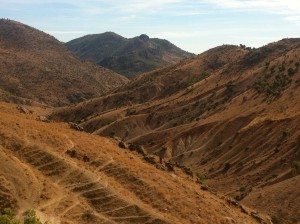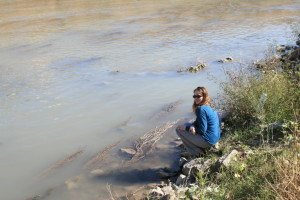I’d heard about historic Armenia for years. I learned about it from the stories of friends whose grandparents were born there. I saw it in the paintings of Saryan. I sang about it in songs like “Giligia” and “Akh Vaspurakan.” I peered into it from the buffer zone on the Armenian side of the border across from Ani. It was a shame, even as a non-Armenian, that I had never visited this part of the world.
All of that changed last week. Finally, I saw where the Vanetsis are from. I rode a ferry to Akhtamar. I hiked to an Armenian monastery in a mountain valley by Lake Van. I walked the ancient city walls of Dikranagerd/Diyarbakir. And I put my hands in the Tigris River.

My last pilgrimage to ancestral lands was 10 years ago. It was to Norway, the birthplace of my great-grandparents and many others before them. I traveled with my then-boyfriend, an Armenian American. Not long before we departed, I had watched his face at Tsitsernakaberd, the genocide memorial in Yerevan. It’s hard for many people to understand century-old pain. Sometimes tears express more than words.
We stayed in the very room where one of my great-grandmothers was born in the south of Norway. The living room of the home was 600 years old. As my cousin described the history of where we sat, I watched tears fall down my boyfriend’s face again. I was young; I didn’t realize how fortunate my family had been. His face helped me understand.
A fundamental reason for the migration of Norwegians to America was a lack of land. One great-grandmother came from a family with 11 children. Even though not all of them survived, there simply wasn’t enough to go around, so she and her brother set off for America. Once there, they took advantage of the Homestead Act to buy farmland that would become my home more than 80 years later.
There is a profound difference between voluntary migration and forced migration, both for those who leave and for those who are left. I can’t pretend to fully understand any of it, but I do know that a few days in Anatolia left me with a heart full of something I can’t quite identify, my head spinning and my mouth unable to articulate why. Maybe because it was too short, maybe because it shouldn’t be reduced to the few words I can muster.

As we drove the countryside last week—the Armenian, the Turk, the Kurd, and me—I was mesmerized by the landscape. I’d seen the paintings of Saryan, but I didn’t know if they were more than the result of a canvas, some paints, and a creative mind. Now I didn’t know whether the painting was in the likeness of the mountains, or we were driving through a painting.
The mountains, I wish I could convey to you how beautiful they are. They’re covered with lines up and down and across, creases created by centuries of laughing and weeping.
In search of an Armenian church in Sassoun, we asked villager after villager for directions, but without success. Suddenly, we saw stones atop a hill, like the ruins of a church, and scrambled up to the site. It was nothing more than stones. Two of my travel companions hiked to another peak while I stared at the valleys that at one time were dotted with Armenian villages.
The next day, we made a leisurely visit to Akhtamar. There is nothing quite like an empty 10th century Armenian church to inspire this odar to sing some Gomidas. We finally left the church to take in the view from two sides of the island. Sitting lazily on some stones under the brilliant blue sky, I received a tutorial in Turkey’s present-day minority relations. What a mess.
My Armenian friend, the esteemed editor of this paper, still defeated from our failed attempt to locate a church the previous day, announced that we would visit the Karmravank monastery complex near Lake Van on our return to Diyarbakir. En route, we picked up a man who was going in that direction. A few minutes later we found ourselves face to face with several hundred sheep. The head shepherd, evidenced by the rifle slung over his shoulder, invited us to have tea and bread. Instead, we parked the car and started our ascent.

There was nothing about my attire that fit the occasion. I wore a black wool sweater and light jacket under the blazing sun, and smooth-bottomed boots with low heels through the sheep turds and dry creek bottom rocks. This worked to my advantage, I realized later. Forced to focus on each and every step, I set aside my first-world problems, like wondering what that day’s breakfast of yogurt fat with butter on top would do to my hips. It became a meditation of living in the moment only, nothing less and nothing more.
When we reached the monastery an hour later, I walked straight through the sanctuary’s low door. The first thing I noticed was a hole in the floor, eerily the size of a grave. Treasure hunters dug it, I was told later. I found it disturbing. My mind wandered to thoughts of what 10th century Armenian monks were like, and why I don’t hike more often.
We listened to music from across the region as we drove, most of it over and over again. There was something desperate about it, something urgent. So much music is like candy, a quick sugar rush and nothing more. There is little in this part of the world that’s like that. It is all real and substantial and sometimes it hurts to chew.
Am I romanticizing things? Maybe. I romanticize most everything. But that can be a good quality in a friend, because I can spin your shit into gold.
One man we met was a hidden Armenian, as they say. His father had been five years old in 1915, and he was the only one of his family to survive the genocide. Now, at perhaps 50 years of age, this man, who was raised a Muslim but aware of his ethnic background, was studying the Armenian language for the first time, thanks to a program sponsored by the city of Diyarbakir. He’d adopted an Armenian name with which he introduced himself, his eyes and smile burning bright with excitement. We lifted our glasses of Assyrian wine to toast—genats—and then drank.
It’s a privilege to hear someone’s story, to try to understand it, and to be a small part of it. That was, at its core, what last week was about. It was about looking through villages long ago razed to the ground, searching for churches now empty and the targets of vandalism and greed, hearing about identities lost and slowly reclaimed.
When I called my parents before leaving, I described this as a trip to what once was, but is no more. That, I learned, is not the beginning and the end. The real world is more nuanced. The real world is about finding solidarity in the human experience. The real world has no beginning, and it has no end.


Kristi, another great article and story! Thank you. My mom’s family were from Dikranagerd (Turkified to Diyarbakir) and survived the Genocide. My grandmother and grandfather told my mother numerous horror stories about their survival. I wonder how many women and their young children drowned themselves in the Tigris River. I would venture to say that you were on sacred ground where you sat by the banks of the river. Thank you, again, for sharing your trip details and for writing such a wonderful article.
Thank you Kristi for sharing your story with us. The example that you are giving is very touchy and very true. I am talking about your example of your grandparent’s side of the story. I feel the same way when my studen’t grandparents come to pick them up to go and visit their grate grandparent who leave in Colorado, Palm Springs or Oklahoma. I always feel different and deprived from that kind of experiences. Why I didn’t have that? Why my great grandmother didn’t have the opportunity to take me to her house and enjoy her cooking with me. I started reading your article when I was sitting in our teachers lounge but in the end I had to move to another room because I was getting emotional and had teary eyes. Yes, these kind of feelings are always part of our life. Thanks again.
Kristi:
if you are ‘Odar’, I am Genghis Khan.
I many ways, you are more Armenian than many ethnic Armenians I know.
Lots of Armenians by birth who speak Armenian and have Armenian names are nothing like an Armenian that I instinctively know one to be. Many Armenians in Diaspora who don’t have Armenian names and don’t speak a word of Armenian are also ‘more Armenian’ than many residents of RoA.
Don’t ask me to describe how I know: as Justice Potter Stewart wrote; “I can’t define it, but I know it when I see it” (about non-commercial copyright works).
You wrote:
“but I do know that a few days in Anatolia left me with a heart full of something I can’t quite identify, my head spinning and my mouth unable to articulate why. “
“The mountains, I wish I could convey to you how beautiful they are. They’re covered with lines up and down and across, creases created by centuries of laughing and weeping.”
There you have it. Felt like a true Armenian.
Kristi, I agree with my friend Avery.
In the reality of today’ diaspora, just what is an Armenian? Someone who is “100 percent” by lineage and does little to identify with their heritage or an individual who “adopted” the culture either through marriage or association… By choice.
An Armenian in the diaspora is by choice. Lyon can embrace it or you can distance yourself from it. It’s the actions and the spirit that make the difference. You embody the spirit of love, respect and identity with Armenia and its culture. You have made a choice and we should be thankful.
Thank you for the kind words, everyone. Yerkar apreq.
Dream on armenians.
Kristi– I read your thoughts and comments with awe; you have a keen appreciation for all things Armenian. Sharing your observations and insight is a gift to everyone who stops long enough to read and reflect.
Having recently visited Armenian, I am appreciative of the nuances that abound. I grew up hearing the whispered comments and veiled stories (because the realities were too grim to speak aloud) about the genocide. Appreciating the beauty of the land, the architecture, and the people is “the solidarity in the human experience.” Thank you for sharing. You make me most grateful.
I wish we would delete the word Odar from out beautiful language. Very derogatory word in my opinion like the Turks have for us Christians. Has no place in our generation.
Ahmet, at least we Armenians are human enough to dream unlike the people who are dead inside and do not even have dreams, and because of their guilty conscious (Armenian genocide) they only have nightmares (that is if they have a conscious).